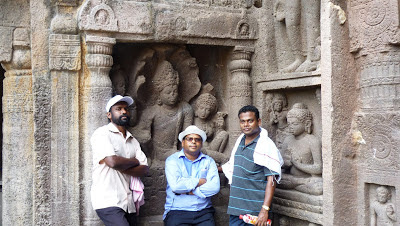I had the opportunity to visit two historical cities, Aurangabad and Ellora, in the state of Maharashtra on a recent weekend trip with 14 of my fellow college mates. The journey by van took almost 7 hours from our campus in Pune.
Our first stop was at the Ajanta Caves (9kms from Aurangabad city). We reached the site after a one and a half kilometre climb across the hillside. There are 30 rock-cut cave monuments which date between the 6th and 8th century B.C. include paintings and sculptures considered to be masterpieces of Buddhist religious art, with Buddha figures and depictions that have been carved using primitive tools such as hammers, pick-axe and chisels. The entire scenery was one of peace and serenity. The site is a protected monument under the Archaeological Survey of India and since 1983, the Ajanta Caves have been a UNESCO World Heritage Site.
On our way down from Ajanta Caves we stopped at the Bibi-Ka-Maqbara Mausoleum. The Bibi-Ka-Maqbara is a beautiful mausoleum of Rabia-ul-Daurani alias Dilras Banu Begum, the wife of the Mughal Emperor Aurangazeb (1658-1707 A.D.). This mausoleum is believed to be constructed by Prince Azam Shah in memory of his mother during 1651 to 1661 A.D. An inscription found on the main entrance door mentions that this mausoleum was designed and erected by Ata-ullah, an architect and Hanspat Rai, an engineer. The mausoleum draws its inspiration from the world famous Taj Mahal of Agra (constructed between 1631 and 1648 A.D.) and hence it is rightfully known as the "Taj of Deccan".
We stayed one night at St Francis de Sales Cathedral in Auragabad. In the morning we celebrated Mass and had breakfast with Rt Rev Bishop Edwin Coloco, Bishop of Aurangabad Diocese before leaving for the Cave Temples of Ellora (28 kms from Aurangabad city). These cave temples represent three religions – Buddhism, Hinduism and Jainism. The 34 cave temples were erected between 6th to 8th Century A.D and they portrayed with carving of gods and goddess. I was not fascinated with these caves compare to the Ajunta Caves. What most captured my sight was a panoramic view of natural waterfall which was situated next to these caves.
Our last spot was Daulatabad (fortress town). It was built on a mountain peak in the shape of a pyramid. It has a beautiful landscape. Cannons were mounted all over the fortress at strategic points. The Chand Minar (tower) located inside the Fort was built in 1435 AD. The height of this fortress is about 183 meters (600 feet). We all climbed to the mountain peak to have a panoramic view of the landscape and town. Only a few of us successfully climbed to the peak of the fortress.
The history of this fortress goes back to the 12th Century AD. The Sultan of Delhi, then, ordered the capital to be moved to the Southern city which had been renamed Daulatabad (Deogiri), the city of fortune. He wanted all his Delhi citizens, whether rich or poor, the sick and dying, to move out from Delhi to the new capital, Daulatabad. (Just imagine - The distance between Delhi and Daulatabad is approximately 1250 kms). In the cause of moving, thousands and thousands Delhi citizens died on the way. In the end, the sultan regretted his decision and ordered his people to move back to Delhi again.
One of my companions told me a story that at that time one cobbler was against the sultan’s order to migrate. The Sultan was so furious. He tied the cobbler and dragged him with a horse from Delhi to Dualatabad. By the time he reached this fortress town, only one of his legs remained. The rest of the body fell into pieces along the way. Then, I realised, that was the reason why they sell toy horses everywhere in this fortress city.
The trip was superb. We had a lot of fun. It was a good break from our studies. I had discovered another part of India – and this time, it was from the historical aspect.



































